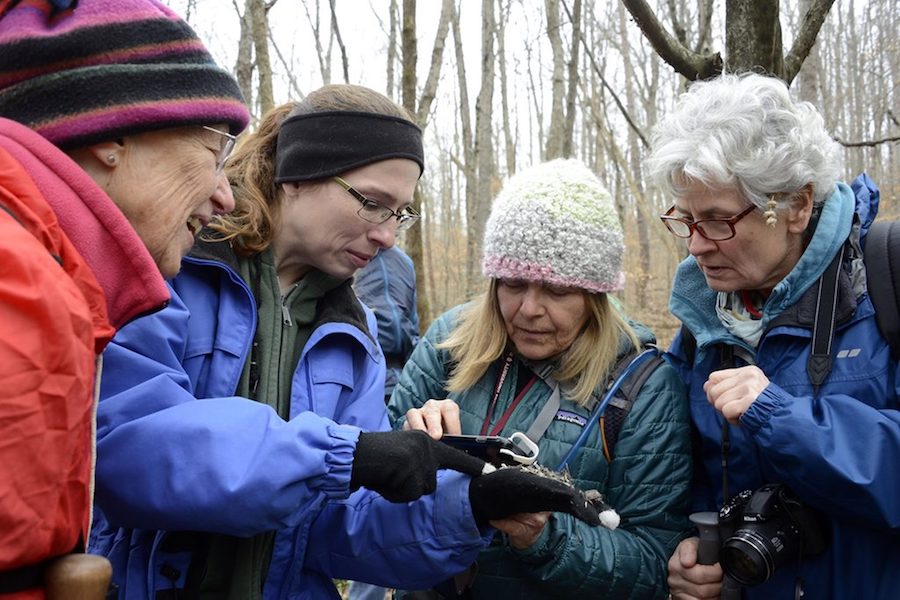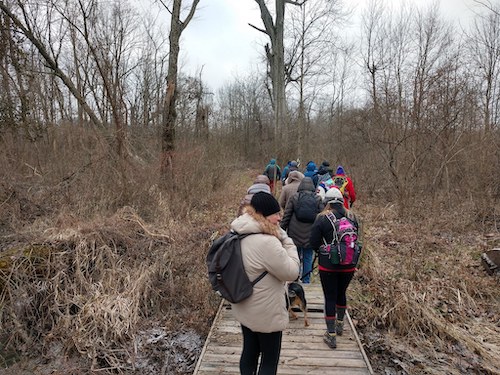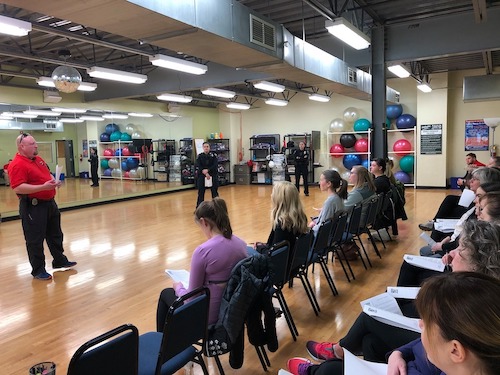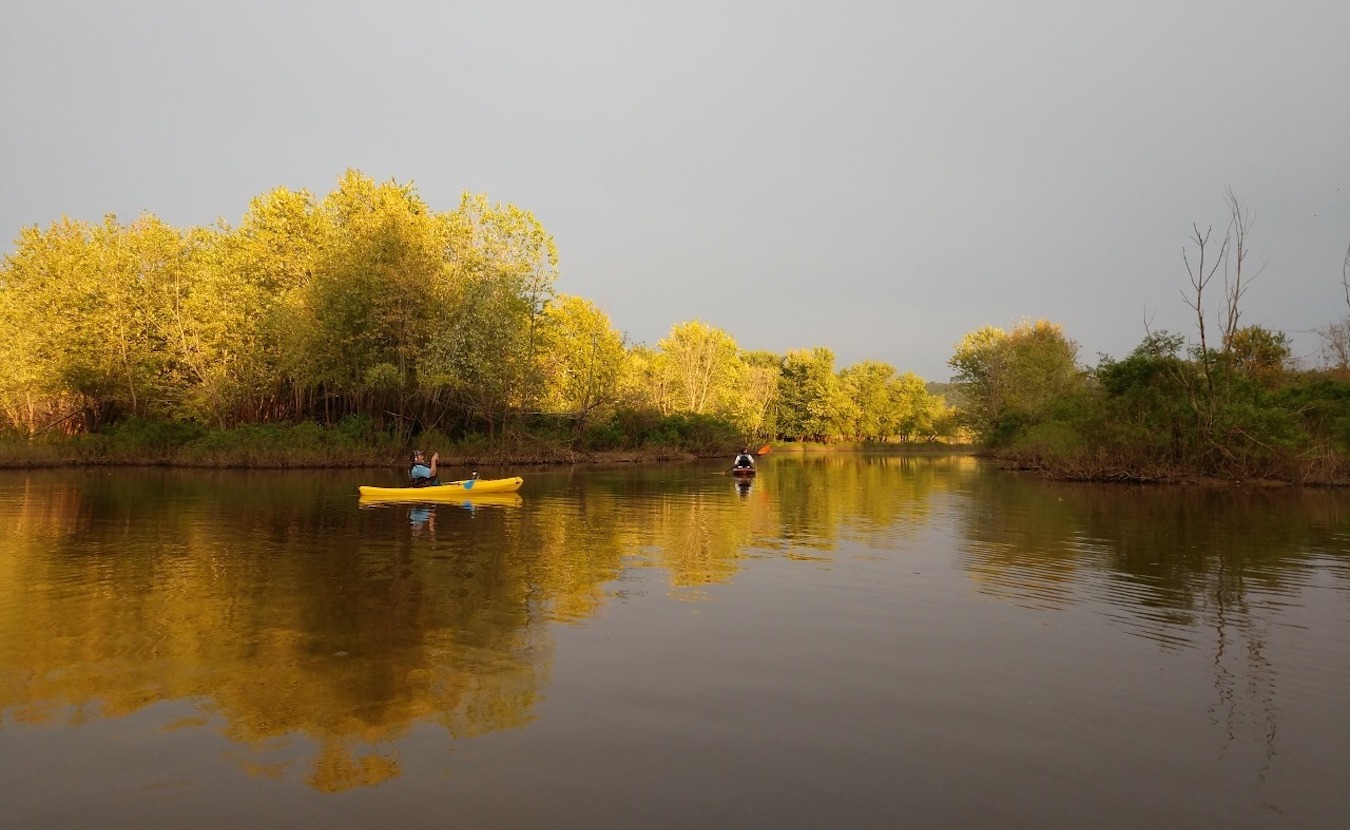Cathy Meyer, recently retired from Monroe County Parks and Recreation, loves the outdoors. A part-time ski instructor, she has hiked sections of the Appalachian Trail, has paddled the Boundary Waters, and helps organize local canoers and kayakers through a Facebook group called B-Town Paddle Pals. When she heard last year from Debra King at the Indiana Department of Natural Resources (DNR) Division of Fish and Wildlife that there was a women’s outdoors group forming, Meyer was all in.
“There’s this macho image of the rugged outdoorsman,” Meyer says. “We know women enjoy outdoors things, too, but don’t want to do it by themselves, not stand out and be the only woman in a group of men. Sometimes it’s easier to learn new skills from other women, rather than have some guy mansplaining things, maybe talking down to women.”

Jill Vance (second from left), a naturalist with Monroe Lake and an organizer of WINGS, guides members during an outdoor event hosted by Monroe Lake. | Photo by Martha Fox
After just two meetings, Women in Nature Gaining Skills (WINGS) was born. For some of the organizers, it was the first time they’d been in a meeting with all women. Jill Vance, a naturalist with Monroe Lake, helped set up the Facebook page. The organizers include Vance, Meyer, and King, as well as Sandy Clark-Kolaks, southern fisheries research biologist with the DNR’s Bloomington field office; Rebecca Jania, natural resources coordinator for the City of Bloomington; and Stacy Duke and Marion Mason of the Hoosier National Forest. Each is committed to leading at least one or two events per month through 2020. The list of 13 programs went up in late 2019, and all events were filled before the new year began. It included activities like archery, hiking, kayaking, birdwatching, and fishing, as well as Dutch Oven cooking. (For women who still want to get in on an event, Vance maintains a list of “standbys” for cancellations. Interested women should email Vance at jvance@dnr.in.gov.)
“Friends are inviting friends, husbands inviting wives,” says Clark-Kolaks. “It’s very organic. We were all shocked when all the events filled up in a couple of months. This shows there’s a desire for this interaction among women.”
The first gathering, in January, featured a winter hike in Flatwoods Park, just west of Ellettsville. “I still run into a lot of people who have no idea that park is there,” says Meyer, who led the one-hour tour in 15-degree weather, followed by hot chocolate and a fireplace chat in the park shelter. Meyer said more than half of the participants had not hiked in the winter before. About 25 women — ranging in age from early 20s on up— bundled up and navigated icy paths.

WINGS’s first event was in January, a hike in Flatwoods Park just west of Ellettsville, in 15-degree weather. | Photo by Jill Vance
The second event, in February, featured a self-defense course.
“Self-defense is one of the unique ideas that happen when you have six women organizing,” says Clark-Kolaks. “We know that safety is a huge concern for women. If four to five guys put an event together, I don’t know if that would occur to them. It is scary if you go to a lake or trail and be there by yourself. It’s very intimidating. To protect yourself is important.”
When the COVID-19 pandemic hit, WINGS put their events on hiatus. Jania had sponsored the self-defense program, and in May she restarted the program by giving her wild edibles presentation and a virtual hike through RCA Park via the virtual meeting app Zoom. A graduate of Indiana University’s O’Neill School of Public and Environmental Affairs, she learned a lot about invasive plant species after working for an environmental restoration company. She taught herself what plants and flowers in the field are safe to munch on. Her program covered “different sustainable etiquette, harvesting wild edibles, safety tips for identification and preparation, and plenty of options for things to wild forage even in our local parks,” she says. And it’s legal to do so in Bloomington parks, but the rule is to forage no more than 20 percent to allow it to regrow. (Every park has rules about what is allowed to be plucked, so check before you take.)
The wild edibles event was recorded, and WINGS plans to have the two-and-a-half-hour program available on its Facebook page and the Bloomington Parks YouTube page. In June, Clark-Kolaks offered the introduction to fishing program via Zoom. Women attendees learned about tackle and bait options and how to prepare a hook and line, among other information. The introduction to kayaking program, which is full and has a long waitlist, will run as scheduled in July.
Margo Morton, a Louisville native and recent Ball State graduate who moved to Bloomington in August, heard about the Facebook group and decided to sign up for the winter hike. She had never been winter hiking.

In February, before the COVID-19 pandemic put events on hold, WINGS held a self-defense course. “Self-defense is one of the unique ideas that happen when you have six women organizing,” says Sandy Clark-Kolaks, one of the WINGS organizers. | Photo by Rebecca Jania
“It was really cool to be able to prove to myself that I could [hike in below-freezing temperatures],” she says. “If it’s really cold, you think, ‘Oh, I wish I could go outside today, but I guess I’ll just stay indoors.’ But now I can tell myself, ‘No you can go outside.’ When you can walk in 15-degree weather, you can do pretty much anything.” Morton was pleased to find a fellow Ball State alumna on the hike, and they exchanged phone numbers.
“We talked for most of the hike and that’s just a connection that you can’t really make as easily if you’re just walking around downtown Bloomington or sitting in a restaurant,” she says.
Encouraging women to get involved in outdoor activities benefits the organizations that employ each of the women who started the group. As Jania says, “One of the biggest untapped demographics for fishing and hunting and other recreational outdoor activities are women.” Because all the revenue from hunting, fishing, and trapping licenses goes to the Indiana DNR Division of Fish and Wildlife, it makes sense to expand the network. The number of licenses purchased in Monroe County has declined over the years, from 11,266 in 2006 to 10,795 in 2019.
Indiana collects about $10 for each fishing license and $50 for each hunting license purchased. In 2018, the state also received $18.1 million in federal money, which was used to manage fish and wildlife resources in Indiana. The department encourages people who don’t hunt or fish to still purchase a combination license ($25 a year for residents) because it can net an additional $60 per license in federal funds for Indiana to use on fish and wildlife conservation.
Meyer summed up the reasons for the group and how it’s been on track to exceed expectations. Ultimately, she says, women are empowered by learning from other women. “So women know there are these things they can do, and they don’t have to wait for their husband or boyfriend to take them and show them and look out for them,” she says.

WINGS put its events on hiatus when the COVID-19 pandemic hit. But one of the organizers, Rebecca Jania, natural resources coordinator for the City of Bloomington, restarted the program with an online “wild edibles” presentation and virtual hike through RCA Park in downtown Bloomington. Her program included “plenty of options for things to wild forage.” Pictured are some of the plants discussed. (l-r) Yellow woodsorrel (Oxalis stricta) is a sour-tasting plant with leaves similar to three-leaf clover — both leaves and flowers can be eaten raw. | Photo by Dcrjsr / CC BY. Poison ivy (Toxicodendron radicans) is not edible but can be identified by its three leaves and a notch in the leaf (“Leaves of three, leave them be,” is a common warning). | Photo by Laurie D. Borman. Dandelion (taraxacum), the entire plant — leaves, flowers, and roots — is edible. | Photo by Laurie D. Borman. Asian honeysuckle (Lonicera tatarica) is an invasive bush, but eating the flowers, which can be sweet, can help prevent it from spreading. | Photo by Laurie D. Borman


